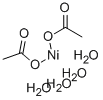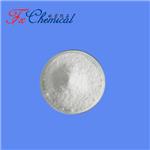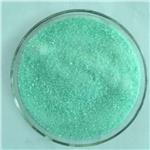Physical Properties
The tetrahydrate is a green crystalline solid; sweet taste; odor of acetic acid; density 1.744 g/cm3; loses water on heating to form a yellow-green powder of anhydrous nickel acetate; decomposes above 250°C; soluble in water, 17g/100mL at 20°C; sparingly soluble in alcohol.
Uses
Nickel acetate is used as a catalyst. It also is used as a dye mordant in textiles. Other applications are in electroplating nickel and as a sealer for anodizing aluminum.
Preparation
Nickel acetate is prepared by reacting nickel hydroxide or nickel carbonate with dilute acetic acid. The tetrahydrate is crystallized from solution.
Ni(OH)2 + 2CH3COOH → (CH3COO)2Ni + 2H2O
NiCO3 + 2CH3COOH → (CH3COO)2Ni + CO2 + 2H2O
On heating, the solution hydrolyzes depositing nickel hydroxide.
Chemical Properties
green monoclinic crystal(s); hygroscopic; used in textiles as a mordant [HAW93]
Uses
Nickel(II) acetate tetrahydrate can be used in synthesis of polynuclear-nickel polyoxotungstate cluster compounds that are ideal for the design of molecular magnets.
Uses
Nickel(II) Acetate Tetrahydrate is a reactant in the synthesis of metalloprophyrazines as active components of membranes of anion-selective electrodes.
reaction suitability
reagent type: catalyst
core: nickel
Safety Profile
Confirmed human
carcinogen. Poison by ingestion and
intraperitoneal routes. Mutation data
reported. When heated to decomposition it
emits acrid smoke and irritating fumes. See
also NICKEL(II) ACETATE and NICKEL
COMPOUNDS.
Purification Methods
The acetate crystallises from aqueous AcOH as the green tetrahydrate salt. It is soluble in 6 parts of H2O. It forms lower hydrates and should be kept in a well-sealed container. [Hardt & Pohlmann Z Anorg Allgem Chem 343 92 1966, Beilstein 2 IV 120.]





